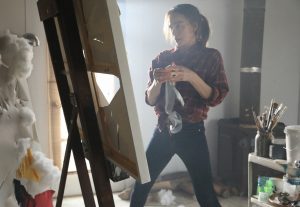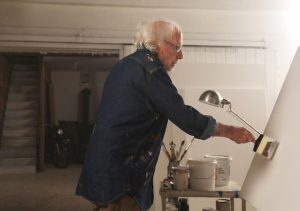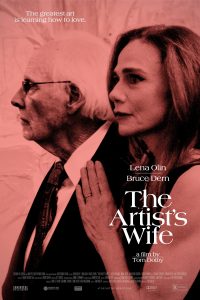‘The Artist’s Wife’ reflects on striking a balance
“The Artist’s Wife” (2019 production, 2020 release). Cast: Lena Olin, Bruce Dern, Juliet Rylance, Avan Jogia, Stefanie Powers, Tonya Pinkins, Catherine Curtin, Caryn West, Ravi Cabot-Conyers. Director: Tom Dolby. Screenplay: Tom Dolby, Nicole Brending and Abdi Nazemian. Web site. Trailer.
Giving our all to a beloved partner is certainly an admirable ambition, one that many of us strive for in hopes of it creating a state of mutual love and support. It’s widely believed such a connection can benefit each spouse, yielding both a flourishing relationship and a foundation for significant personal growth and development. But at what point does such devotion to another become unhealthy, leading to a lopsided bond? That’s a question explored in the new romantic drama, “The Artist’s Wife.”
For years, onetime-aspiring artist Claire Smythson (Lena Olin) has committed herself to supporting and promoting the painting career of her husband, Richard (Bruce Dern). It’s an effort that has paid off in many ways, too, as it has helped her remarkably talented spouse become an affluent and renowned icon in the abstract art world. And publicly he generously credits Claire for much of his success. From all appearances, it would seem that this is an arrangement that has worked well for both of them, as it has brought Richard acclaim while providing Claire with a comfortable life. However, as we all know, looks can be deceiving.
For starters, to be able to help Richard build his career, Claire gave up her own pursuit of becoming a painter, a gesture she quietly seems to regret, despite efforts to downplay her feelings. From what we see of her work, though, that could be viewed as a lamentable decision; she appears to possess a tremendous talent of her own, one that’s gone untapped and unrecognized in the shadow of her husband’s accomplishments. And, as she gets on in years, she’s beginning to look back on that move with some misgivings.

Abstract art icon Richard Smythson (Bruce Dern, left) gives all the credit for his success to his wife Claire (Lena Olin, right), a onetime-aspiring painter who gave up her career to promote and support her husband in director Tom Dolby’s “The Artist’s Wife.” Photo courtesy of Strand Releasing.
Those misgivings are driven in part by her aging husband’s failing health. Richard appears to be in the beginning stages of Alzheimer’s disease, and the condition is starting to exacerbate some of his less-than-flattering qualities. His temperamental, capricious and egotistical nature can be difficult enough to deal with in itself, but, now that he’s been afflicted by an illness that carries its own degree of unpredictability, he’s become quite a handful to deal with. These circumstances call for even more of Claire’s time and attention, impinging not only on her ability to follow her own pursuits, but also to attend to the routine, mundane activities of everyday life. To call her situation exhausting would indeed be an understatement.
But Claire’s challenges don’t end there. Given Richard’s declining health, she tries reaching out to his daughter from his first marriage, Angela (Juliet Rylance), from whom he has been estranged for years. As a single mother raising a young son, Gogo (Ravi Cabot-Conyers), with the help of a live-in caretaker, Danny (Avan Jogia), Angela opposes contact of any kind with her father, despite his failing condition and any of Claire’s overtures to smooth relations between them while time remains.
And then there’s Richard, who brings additional challenges to the table. As his condition worsens, he’s unable to carry through on his obligations as he once was able to. His biggest challenge is creating the works for a new gallery show, one widely considered to be his last. However, with the deadline looming, his inspiration appears to have abandoned him, and he’s running out of time to come up with the pieces promised to an increasingly impatient gallery owner (Tonya Pinkins). On top of this, Richard’s progressively unpredictable behavior in the university painting class he teaches – most notably profanity-laden diatribes leveled against his students’ works – has placed his position in jeopardy. His frequent outbursts and tantrums try the patience of everyone around him, but especially Claire as she attempts to offer comfort and reassurance in the face of his growing anguish and frustration.

With the years passing her by, onetime-aspiring artist Claire Smythson (Lena Olin) gets the itch to return to the painting career she gave up to support the work of her husband in “The Artist’s Wife.” Photo courtesy of Strand Releasing.
Needless to say, this all creates a rather full plate for the ever-devoted wife. But how much longer can she hold up under these conditions, especially with pressure mounting from both Richard and everyone else? Circumstances make her wonder whether she’ll be able to keep up with everything, let alone make a meaningful difference. She increasingly reflects on whether everything she has done for her husband has been worth it, both in terms of personal, vocational and even romantic satisfaction. But, despite these conditions, she’s not without support, such as the sage advice given to her by a flamboyant old friend from the arts community, Ada Risi (Stefanie Powers). The question is, of course, will she take it to heart?
As the situation intensifies, Claire is faced with some hard choices. Can she help Richard in the ways he needs it, or is it a lost cause? Can she help mend the fences between a long-alienated father and daughter? And is she willing to finally address the fulfillment of her own long-overdue overlooked needs? Perhaps it’s possible, but doing so may require some bold creative steps of her own, some that could finally allow her to become an “artist” in her own right – and in ways that are unexpected and unconventional at that.
Having a loving partner who is willing to freely do whatever it takes to support our endeavors is indeed a blessing. But what happens when the requirements of that backing become so burdensome that they compromise our significant other’s own existence, depriving our partner’s ability to pursue his or her own interests – or perhaps to even function on a daily basis? What’s more, why would someone willingly subject one’s partner (or, even more tellingly, himself or herself) to such onerous conditions? Is love really enough to sustain such a potentially unbalanced relationship? Those are some of the questions that Claire and Richard now find themselves up against.

Aging abstract artist Richard Smythson (Bruce Dern) laments the abandonment of his inspiration as he frustratingly attempts to prepare for a new gallery show in the new romantic drama, “The Artist’s Wife,” now available for first-run online streaming. Photo courtesy of Strand Releasing.
In essence, circumstances come down to what the partners believe about their relationship, their responsibilities to one another and themselves. And those beliefs, in turn, shape the reality they experience, a product of the conscious creation process, the philosophy that maintains we draw upon those resources in manifesting our existence. That’s very much the case here, and the dynamics involved are indeed significant on multiple levels.
Claire, for example, is torn between what she sees as her duties to Richard and the pursuit of her own ventures. In many ways, these endeavors could be viewed as being at odds with one another, a stalemate that’s growing increasingly difficult to resolve and the source of the building stress and frustration in her daily routine. She obviously loves her husband and wants to do right by him, both as a committed spouse and as a supporter of his calling. But, now that Richard has developed Alzheimer’s, the requirements for caring for his well-being alone have expanded significantly, let alone attending to the needs of helping him keep his career on track. And her own pursuits, to say the least, have been relegated to the back burner, despite her mounting urge to revive them.
To reconcile this situation, Claire must ask herself what she wants and determine what beliefs she needs to put into place to make that happen. One step that’s especially critical in this is being willing to be honest with herself, to focus on assessing the needs of her authentic self. On the one hand, she believes in being supportive of Richard, but is it too much for her to handle? At the same time, she’s obviously questioning the wisdom of continually putting herself second, subverting her genuine desire to return to her own painting projects. Can she truly feel contented by playing the role of caretaker exclusively? Or does she require more? Is it thus incumbent upon her to give herself permission to move beyond her primary obligations?
This naturally raises the question, how did Claire end up in this scenario in the first place? And what role did Richard play in it? If he indeed loves his wife, why would he make it so difficult on her, even if unwittingly?
It could be argued that perhaps Richard is forcing Claire’s hand. By continually placing more and more demands upon her, he could be pushing her to grow so frustrated with her circumstances that she can’t help but assert herself (probably because her devotion to him would have otherwise prevented her from taking the initiative to do so on her own). That’s a rather difficult way of achieving such a result, but sometimes drastic measures are necessary when simpler means aren’t invoked or even considered. Superficially, such efforts may not be seen as helping, but sometimes intents can be obscured, their masks backhandedly essential to ultimately evoking a desired result.

The onset of Alzheimer’s disease brings new challenges to the marriage of abstract artist Richard Smythson (Bruce Dern, right) and his attentive spouse, Claire (Lena Olin, left), in the new romantic drama, “The Artist’s Wife.” Photo courtesy of Strand Releasing.
Of course, given Claire’s temperament, tending to her husband’s needs is only part of what she’s attempting to do. She’s also seeking to build bridges between Richard and Angela, an almost-thankless task in itself. Given everything else on her plate, one might see Claire as a glutton for punishment, noble intents aside. However, considering her nature to be supportive and compassionate, this undertaking is right in line with her true self. What’s important here, though, is that she must recognize the role she should play – that of being a mediator to bring father and daughter together and then letting them do the work of sorting out what kind of relationship they want for the future. Can Claire keep her beliefs in check enough to accomplish this? That, obviously, is up to her.
All of this ultimately could prove challenging in light of Claire’s value fulfillment, the conscious creation concept associated with being our best, truest selves for the betterment of ourselves and those around us. If Claire is to really make the most of this, however, she must remember that value fulfillment is more than just being of service to others; it also means being of service to ourselves. No one would argue that she doesn’t have the first part down cold, but, as for that second condition – being of service to herself – she’s got her work cut out for her, and the nagging feelings she has about not living up to that serve as a less-than-subtle reminder that she needs to attend to it. Will she get there? That remains to be seen, but, as an artist at heart, perhaps there is a way for her to bring it about so that it fulfills both prongs of what constitutes bona fide value fulfillment. The result could be rewarding in ways that satisfy the needs of everyone – including herself (at last).
This moving, if sometimes slightly disjointed, look at the life of a spouse seeking to be loving and supportive while addressing her own needs presents a profile of a character frustrated while attempting to be conciliatory in multiple regards. In doing so, it draws together a variety of narrative threads, recalling a diverse array of pictures. It depicts the tragedy of Alzheimer’s, as seen in films like “Away from Her” (2006) and “Still Alice” (2014). It shows the integral but often-thankless efforts put forth by supportive spouses who operate in the shadows and receive little credit for their work, as seen in “Pollock” (2000) and “The Wife” (2017). And it’s a personally heartfelt project for director Tom Dolby, loosely illustrating the final days of his father, sound engineer Ray Dolby, creator of the Dolby noise reduction system who suffered from Alzheimer’s. The superb lead performances by Olin and Dern, backed by a fine supporting cast, really make this picture work, helping it shine even when its sometimes-meandering narrative lets them down. Still, “The Artist’s Wife” represents a worthwhile candidate for awards season, especially in the acting categories. The film has been playing the festival circuit and is available for streaming online.

Striking a balance between what we feel we need to provide others and what we need to do for ourselves can be like walking a proverbial tightrope. That’s especially true when the situation has been impacted by difficult extenuating circumstances. It may even be enough for many of us to want to give up hope. But remembering that we can be of no service to others if we fail to do the same for ourselves is crucial if any of these needs are to be met.
As Richard observes in a TV interview early on in the film, “I create the art; she creates the rest of our lives.” That’s admirable and quite an accomplishment. It also represents a tremendous responsibility, one that can only be fulfilled with a properly balanced perspective. We can only hope Claire learns how to fulfill this requirement – and that her example can help enlighten the rest of us.
Copyright © 2020, by Brent Marchant. All rights reserved.




Leave A Comment